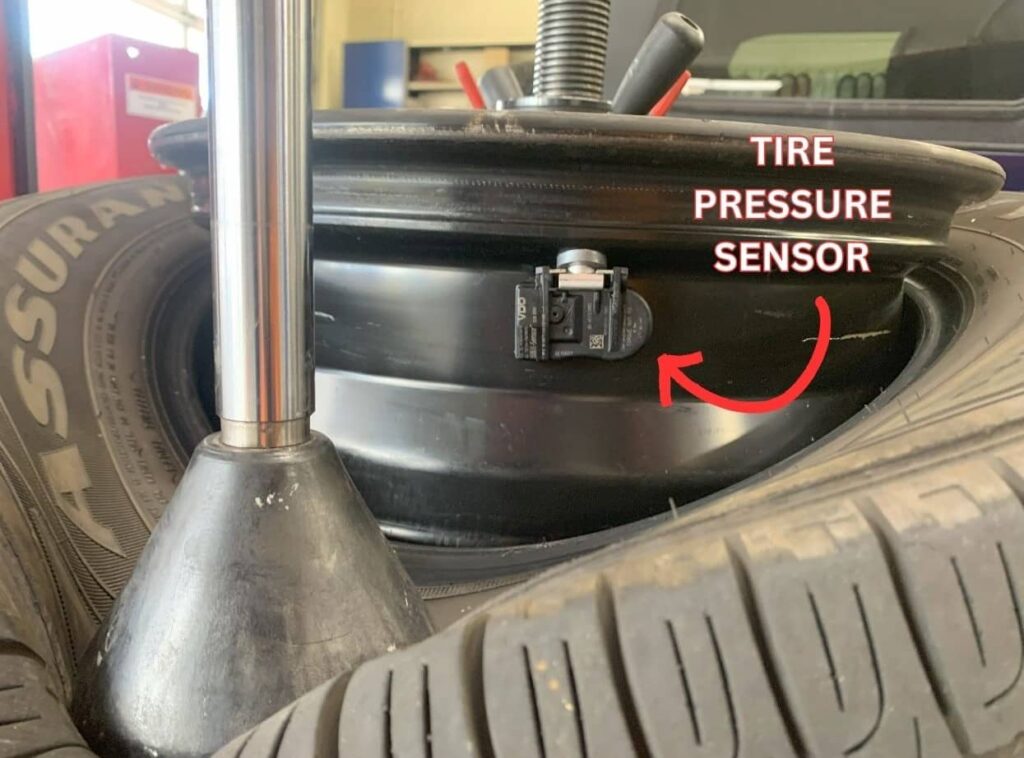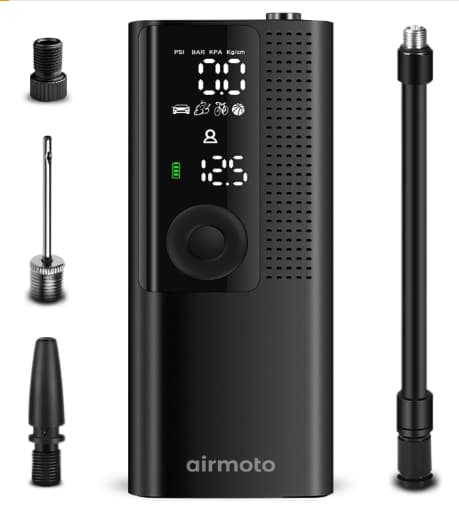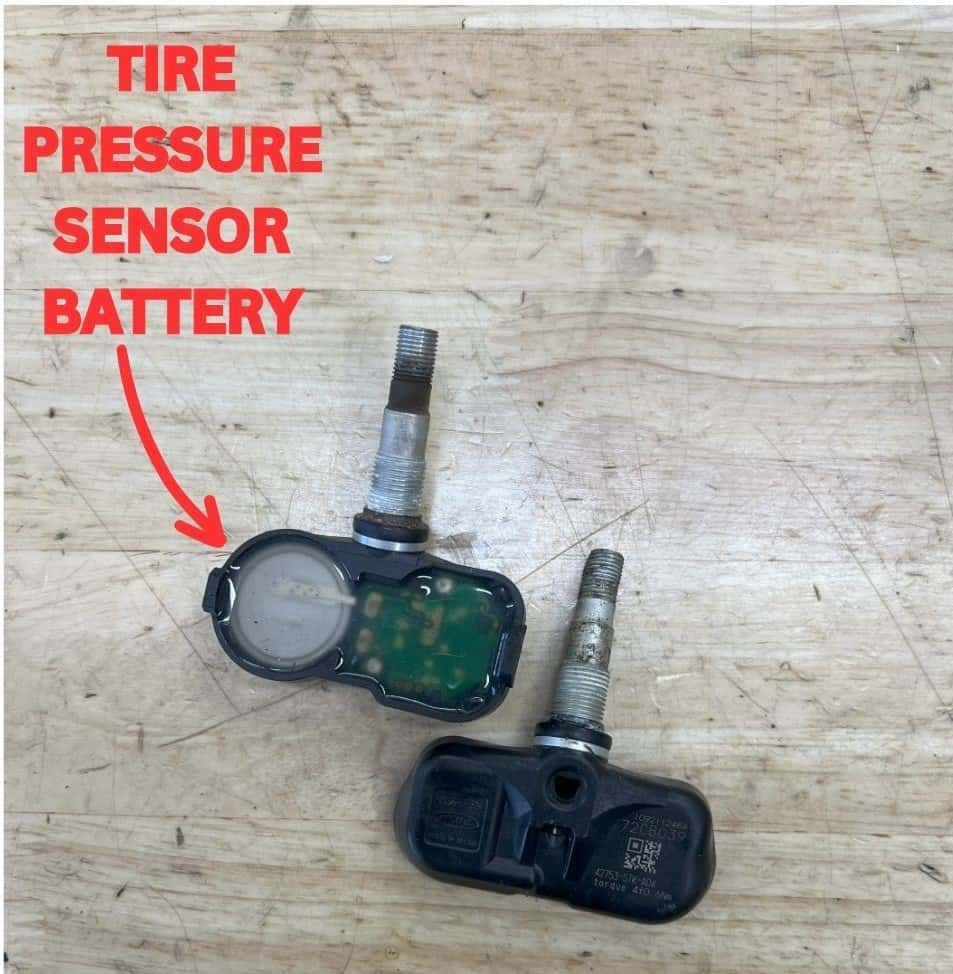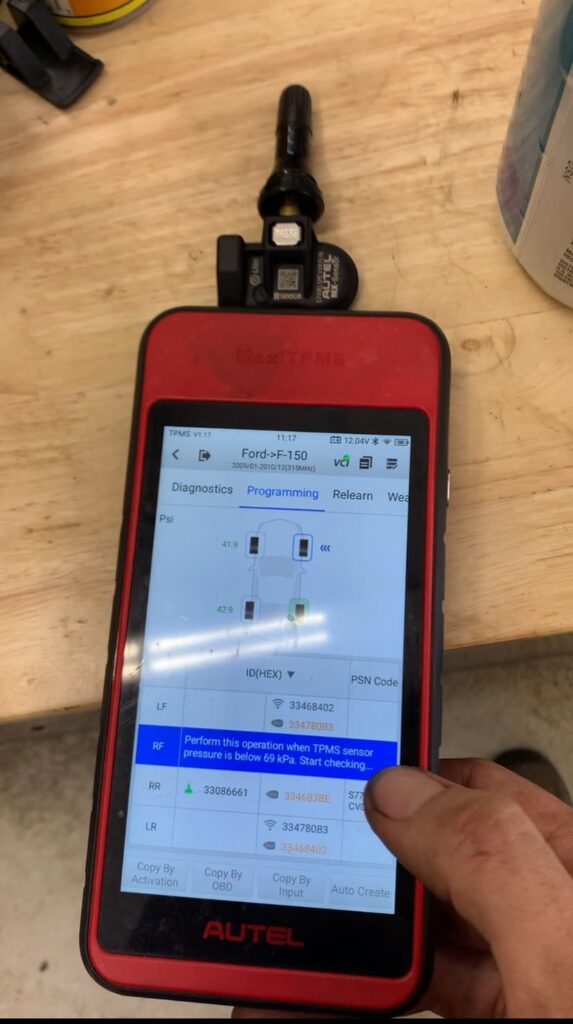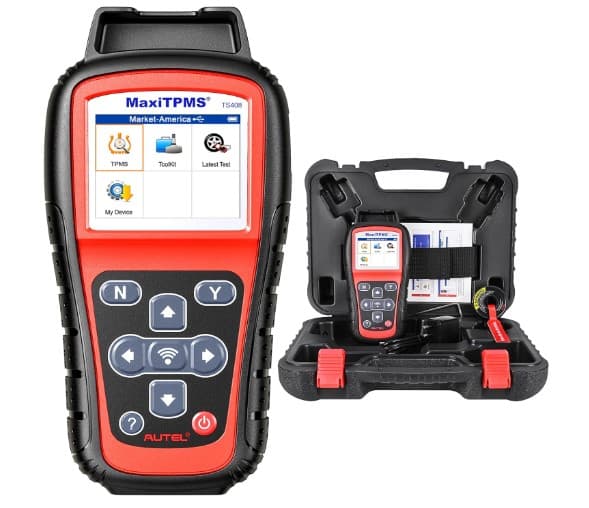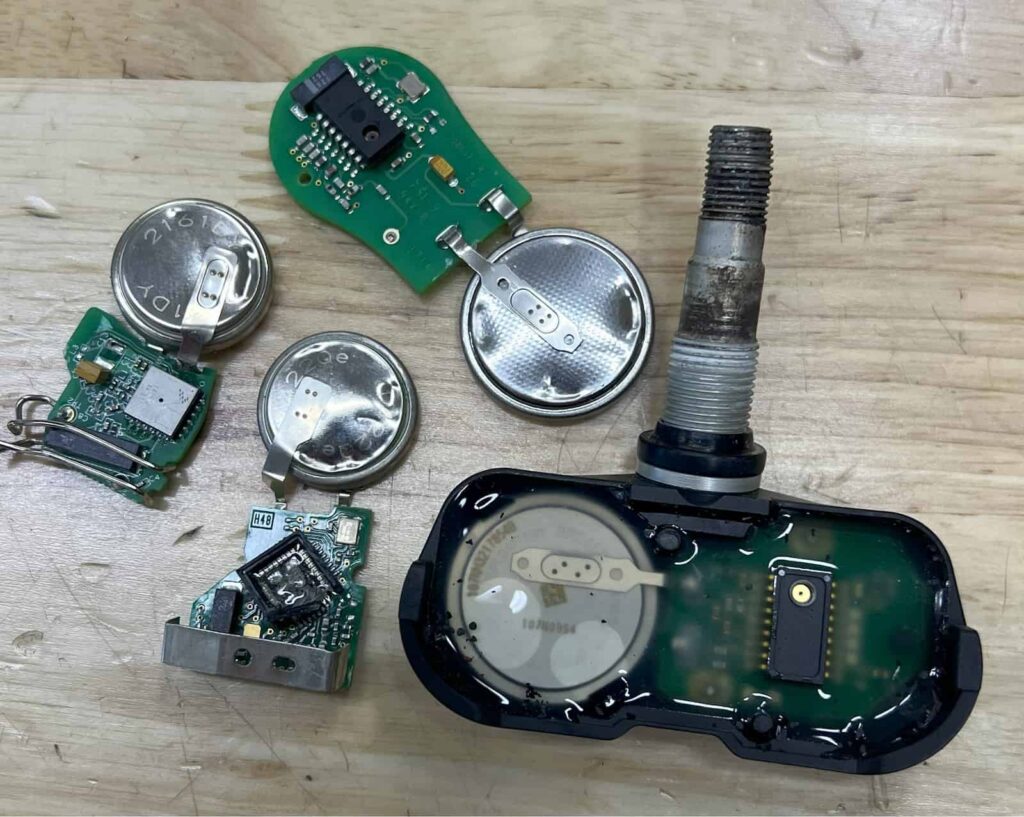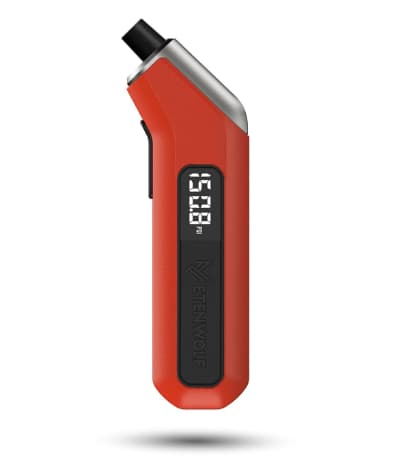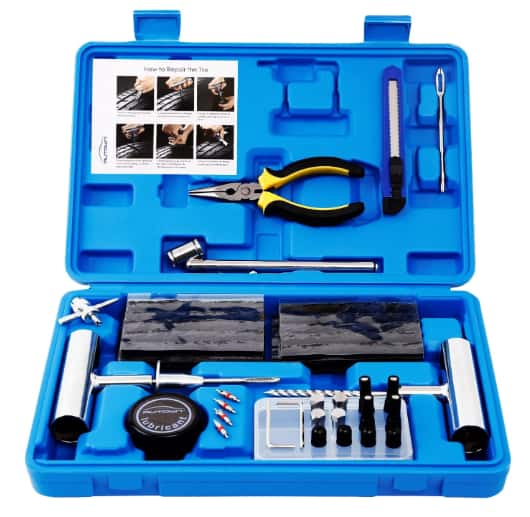STEPS TO RESET TOYOTA Highlander TIRE PRESSURE MONITORING SYSTEM
STEPS TO RESET TOYOTA HIGHLANDER TIRE PRESSURE LIGHT (2004-2015)
Adjust the Toyota Highlander tire pressure to the specified recommendations for all tires
Start the engine.
Underneath the steering wheel, locate and hold the TPMS reset button, identified by a “SET” inscription.
The low tire pressure light on Toyota Highlander will blink on the dashboard 3 times and then turn off.
Once the flashing of the tire pressure light stops, let go of the TPMS “set” button.
Drive your Toyota Highlander at speeds greater than 24 Mph got 5-10 minutes.
STEPS TO RESET TOYOTA HIGHLANDER TIRE PRESSURE LIGHT (2017-2025) INCLUDING NON-US VERSIONS
Examine and fill up the air pressure in the four main tires and the spare tire, ensuring they meet the Toyota Highlander’s specified tire pressure recommendations.
Turn on the engine.
Use the right or left steering wheel’s arrow buttons to sift through the information display until you arrive at the Settings menu.
Press the Down arrow to scroll to VEHICLE SETTINGS and confirm your choice by holding down the OK button for two to three seconds.
With the TPMS option highlighted, hold down the OK button.
Select SET PRESSURE by holding down the OK button on the steering wheel.
You will see a notification that reads “Setting TPMS” to confirm the action.
WHAT TO DO IF THE TOYOTA HIGHLANDER TPMS RESET PROCEDURE DID NOT WORK?
Should the tire pressure indicator remain illuminated after pressing and holding the Toyota Highlander TPMS reset button, switch off the engine and the vehicle’s power, double check the air pressure, then complete the Toyota TPMS reset procedure at least once more. Ensure that every door and the hood are securely shut.
WHY DIDN'T THE TOYOTA TPMS RESET PROCEDURE WORK?
There are 4 main causes why the Toyota Highlander tire pressure light reset process did not work:
Insufficient Toyota Highlander tire pressure or leakage in the tires is the primary reason for the reset process’s failure. Conduct a thorough inspection of the Toyota Highlander tire pressure across all tires. Identifying a decrease in pressure since your last assessment indicates a leak.
The failure may also be due to the Toyota Highlander tire pressure sensors that are either low on power or completely drained. A TPMS diagnostic tool will be required to ascertain which sensor is dead.
The issue could also stem from the spare tire if it includes a tire pressure sensor and is low on air. A difference in valve stem materials—metal for regular tires and rubber for the spare—might suggest a missing sensor in the spare. In cases where all valve stems are metal but the spare’s is rubber, this means the spare does not have a sensor in it.
Stuck or frozen tire pressure sensors. Occasionally Toyota tire pressure sensors stop working due to the cold or other environmental reasons. Overfill the tire pressure by at least 10 Psi and then slowly release the air from the tires.
TOYOTA HIGHLANDER TIRE PRESSURE MONITORING SYSTEM EXPLAINED
The Toyota Highlander tire pressure monitoring system (TPMS) is Integral to its operational safety and efficiency as well as serving to keep the tire pressure in check. It comprises sensors in each of the four tires and a dedicated TPMS receiver module, all of which are integrated with the vehicle’s on board computer system (either ECU or ECM). Far from being just an added feature, the Toyota TPMS is essential for safety, epitomizing the progress in automotive technologies with a focus on extending the durability of the vehicle and ensuring the safety of its occupants.
TOYOTA HIGHLANDER TPMS COMPONENTS AND HOW THEY WORK
TOYOTA HIGHLANDER TIRE PRESSURE SENSORS
Each Toyota Highlander tire features a dedicated tire pressure monitoring sensor, securely contained within a miniature plastic enclosure connected to the valve stem. With each sensor houses a microcontroller, battery, pressure transducer, and a dual-function transmitter and antenna. This is how Toyota tire pressure sensors work:
Pressure Transducer: Acts to convert physical tire pressure measurements into electrical signals.
Microcontroller: Analyzes the signal from the pressure transducer, converting it into a structured data format.
Transmitter and Antenna: Employed for the wireless communication of data to the TPMS receiver module within the Toyota Highlander.
To summarize, the battery-powered microcontroller, essentially a small semiconductor chip, accurately records the tire’s pressure levels. Subsequently, this information is relayed to the vehicle’s TPMS receiver module through the use of radio waves by the transmitter.
TOYOTA HIGHLANDER TPMS RECEIVER MODULE
Integral to the system, the TPMS receiver module is responsible for receiving air pressure information from each tire’s sensor, and then relaying this data to the Toyota Highlander’s onboard computer system, known as the ECU/BCM.
Capturing Signals from Each Tire Sensor: The Toyota Highlander TPMS receiver module is located inside the vehicle’s structure, often under the dashboard or adjacent to the center console. The receiver module is designed to pick up data transmitted by the tire sensors at regular intervals as the vehicle is driven, ensuring the tire pressure is continuously monitored.
Processing and Integrating Data: When a signal is captured, the receiver module proceeds to process this information. It decodes the transmitted signal to retrieve the tire pressure readings and identifies which tire the data corresponds to.
TOYOTA HIGHLANDER ON BOARD COMPUTER
The Toyota Highlander on board computer, also known as the engine control unit is essential for tire pressure data management. This unit receives tire pressure data from the receiver module and compares it with Toyota’s specified air pressure norms. Upon discovering any significant disparity from the recommended pressure levels in a tire, the ECU initiates an alarm. Such alerts often manifest on the dashboard as an exact tire pressure reading, a warning light indicating low pressure, or a textual message on the display screen. Furthermore, the ECU is also responsible for displaying the tire pressure in real-time on the Toyota Highlander’s information display screen.
2017-2025 TOYOTA HIGHLANDER TIRE PRESSURE AND SIZE
TIRE SIZE | Front Psi/Bar | Rear Psi/Bar |
235/65R18 | 36/2.4 | 36/2.4 |
235/55R20 | 36/2.4 | 36/2.4 |
WHAT TO DO FIRST IF YOUR TOYOTA TIRE LIGHT TURNS ON
Upon the illumination of the Toyota Highlander low tire pressure light, safely pull to the side and employ a digital gauge to check the tire pressure. Inspect each tire and wheel visually for signs of damage or irregularities. If the Toyota Highlander low tire pressure light deactivates after you’ve adjusted the tire pressures to their recommended Psi levels, this indicates the effective operation of the tire pressure monitoring system.
WHY IS THE TOYOTA HIGHLANDER LOW TIRE PRESSURE LIGHT ON?
Wrong Tire Pressure: Low tire pressure.
Spare Tire: If the spare tire is being used.
Battery Problems in TPMS Sensors: Worn-out or defective batteries in the pressure sensors.
Complications with TPMS Receiver or Control Units: Technical malfunctions in the receiver or the vehicle’s ECM/ECU.
Interference from External Devices: Electromagnetic fields from electronic gadgets like smartphones, radios, and alarms.
Major Air Temperature Shifts: Significant temperature drops or increases affecting the tire’s pressure resulting in the Toyota Highlander tire pressure light.
Excessive Vehicle Load: Surpassing the vehicle’s weight or towing capacity.
Using Tire Chains: Chains on the tires impacting the accuracy of pressure sensor readings.
Overly Tinted Windows: Very dark window tints interfering with sensor operations.
Road Temperature Changes: Significant shifts in the temperature of the pavement.
Non-Standard Tire Size or Type: Using tires that are not recommended for the Toyota Highlander.
TPMS Sensor or Valve Stem Damage: Incidents of damage during tire changes or upkeep.
Omission of TPMS Recalibration: Not resetting the TPMS following tire or maintenance work.
Air Leaks or Tire Punctures: Issues causing gradual loss of air pressure.
Physical Damage to Tires or Wheels: Harm from road debris or natural deterioration.
Faulty or Improperly Fitted Valve Stems: Damaged or broken valve stems.
WHY COLD TIRES ARE IDEAL FOR ADJUSTING TIRE PRESSURE
For precise and secure adjustments of tire pressure, measuring and setting the pressure in cold tires is vital, as stipulated in the manufacturer’s guidelines. A change in temperature of 10°F can cause tire pressure to alter by approximately 1-2 psi, and this pressure is likely to increase by 4-5 psi when the tires are heated from usage, potentially resulting in deceptive readings. Tires are considered cold and at their most accurate for measuring when they have not been driven on or have been stationary for at least 3 hours.
WHY YOU SHOULDN'T DRIVE AND THEN ADJUST YOUR TIRE PRESSURE
Driving your Toyota Highlander for a mere 25 minutes can result in a natural increase in tire air pressure of about 3-5 Psi, because of the heat generated between the tire and the road surface. Consider a scenario where the tire pressure warning is illuminated, and after a 25-minute drive to a service station, the tire pressure gauge shows 29 Psi. In reality, the accurate “Cold tire pressure” might be around 25 Psi, which underscores the risk of overinflating the tires by mistake. To avoid this, it’s critical to check and regulate your tire pressure only when the tires are cold.
TOYOTA HIGHLANDER TIRE PRESSURE SENSOR BATTERY LIFE
In the Toyota Highlander, every tire pressure sensor is equipped with a non-replaceable, non-rechargeable silver oxide battery. These batteries are designed to endure between 5 to 15 years or around 100,000-150,000 miles of use. When the battery life of a sensor ends, the entire sensor requires replacement. To evaluate the battery status of your Toyota Highlander’s tire pressure sensors, a TPMS diagnostic tool is essential.
HOW DO SPECIAL TPMS TOOLS WORK?
TPMS diagnostic devices are engineered to facilitate communication with the TPMS sensors by emitting a radio frequency (RF) signal that prompts the sensors to relay data back, including metrics like tire pressure, temperature, battery life, signal efficacy, and the sensor’s unique identifying number. The diagnostic device collects this data for display, thus permitting technicians to confirm the functionality and condition of each TPMS sensor. Such tools play a pivotal role in diagnosing common issues, including sensor failures or battery expiration. Furthermore, the more sophisticated TPMS diagnostic devices come equipped with features that allow for sensor reprogramming, software updates, or executing a relearning sequence to acquaint the vehicle’s main computer with new sensors.
USING TPMS DIAGNOSTIC TOOLS
After examining the output from the TPMS diagnostic tool, sensors that display low battery levels or provide erroneous readings (such as registering 0 psi in a tire that is actually at 33 psi) must be substituted with new ones. These newly installed sensors require programming to ensure compatibility with the Toyota Highlander’s ECU.
FIXING FALSE LOW TIRE PRESSURE LIGHT ALERTS
In the event that the tire pressure sensors are operational but the low tire pressure warning won’t turn off:
Temporarily increase the pressure in each tire to around 40-45 Psi.
Carefully decrease the air pressure in each tire to an approximate level of 33 Psi.
Proceed with the reset protocol for the Toyota tire pressure warning light.
Drive the Toyota Highlander for an estimated duration of 10 minutes.
Release the additional air from the tires to normalize the pressure.
IS IT SAFE TO DRIVE THE TOYOTA HIGHLANDER WITH THE LOW TIRE LIGHT ON?
No it is not safe to drive your Toyota Tundra if the tires are not inflated according to specifications. It is vital to quickly fix or substitute a tire that is deflating. If the low tire pressure indicator is activated due to a sensor battery running low, it is still permissible to drive, assuming the tires are properly inflated.
HOW FAR CAN YOU DRIVE THE TOYOTA HIGHLANDER WHEN THE TIRE LIGHT IS ON?
There is no specific distance or time frame that is safe to drive once the Toyota Highlander low tire pressure warning light is illuminated. Immediate action is advised: pull over when safely possible, visually check each tire, and manually measure the tire pressures with a digital gauge. It’s advisable not to depend exclusively on the tire pressure information displayed by the vehicle’s onboard system.
HOW TO HANDLE TOYOTA TIRE PRESSURE SENSORS WHEN CHANGING WHEELS
For those looking to replace the wheels or rims on a Toyota Highlander, you’re presented with a couple of options:
Reuse the existing OEM Toyota Highlander tire pressure sensors by moving them to the new wheels.
Install programmable tire pressure sensors (I recommend Autel programmable sensors) on the new wheels and program them to communicate with the Toyota Highlander’s ECU, which requires a TPMS programming tool.
When swapping out tires on the Toyota Highlander, ensure to follow the established procedure for resetting the Toyota tire pressure warning light.
WHY IS THE TOYOTA TIRE LIGHT FLASHING?
If your Toyota Highlander tire pressure warning light starts flashing, it alerts to a disruption in the communication between the tire pressure sensors and the vehicle’s on board computer, marking a TPMS system malfunction. Commonly, this problem originates from three key sources:
The deployment of the car’s spare tire, assuming it’s not equipped with a TPMS sensor.
A tire pressure sensor’s battery is either depleted or on the verge of running out.
A malfunction or damage in a tire pressure sensor is causing it to lose contact with the Toyota’s TPMS receiver module.
WILL THE WEATHER TRIGGER THE TOYOTA HIGHLANDER LOW TIRE PRESSURE WARNING?
Changes in weather often lead to the low tire pressure indicator being triggered. For each 10°F shift in external temperature, tire pressure adjusts by roughly 1 Psi. Consequently, should there be a 45°F reduction in temperature over a period of a month, the tire pressure in your Toyota Highlander could fall from 31 Psi to 26 Psi, thereby illuminating the low tire pressure light.
WHY THE HIGHLANDER TIRE LIGHT IS ON WHEN THE TIRES SEEM OKAY
Judging the condition of your tires merely by appearance is not advisable. Always use a digital tire pressure gauge to accurately measure the air pressure in your Toyota Highlander’s tires, particularly when you believe there might be an issue. The deactivation of the low tire pressure alert after inflating the tires confirms the effective operation of the Toyota Highlander Tire Pressure Monitoring System (TPMS).
FIND A TIRE LEAK USING SOAP, WATER, & A SPRAY BOTTLE
To pinpoint a leak in a tire accurately, execute the steps below:
Inflate the tire under with low pressure to a minimum pressure of 40 Psi.
Mix soap and water in a spray bottle. (windex also works)
Coat the tire thoroughly with the soapy solution, with special attention to the bead and valve stem areas.
Look for bubble formation on the tire surface and trace these bubbles to locate the leak’s origin.
Highlight the leak’s position with chalk for an easy repair.
STEPS TO RESET THE toyota higlander TPMS BY DISCONNECTING THE BATTERY
If resetting and adjusting the tire pressure system does not extinguish the Toyota Highlander low tire pressure warning, the disconnection of the main 12-volt battery might be required to eliminate any TPMS diagnostic codes from the Toyota’s on board computer. To do this:
Turn off the engine and all electrical components (including the radio and lights).
Unfasten and remove the negative terminal clamp from the battery.
Pause momentarily before re-securing the terminal clamp to the battery.
This approach should resolve the low tire pressure warning issue. Nonetheless, if the low tire pressure alert reappears during driving, it might point to a malfunctioning tire pressure sensor or a tire that is experiencing a slow loss of air.
THE Impact TIRE PRESSURE Makes on AND FUEL Efficiency
Ensuring that the tires on your Toyota Highlander are filled to the recommended air pressure is vital for achieving the best fuel economy. Insufficiently inflated tires lead to increased rolling resistance, compelling the engine to work harder and burn more fuel. A deficit of 10 psi in tire pressure could result in a decrease of fuel efficiency by 2%. Though these figures may seem insignificant at first glance, they can add up to substantial fuel savings or costs over the vehicle’s lifespan.
FAQ
CAN THE TOYOTA HIGHLANDER TPMS BE DISABLED?
No. In the Toyota Highlander, the tire pressure monitoring system (TPMS) is engineered to operate continuously without the option for deactivation. Removing the tire pressure sensors and replacing them with non-sensor valve stems will cause the tire pressure warning to blink initially, followed by a constant illumination, indicating a malfunction in the Tire Pressure Monitoring System.
IS THE TPMS WARNING TRIGGERED BY CHANGES IN ALTITUDE?
No. Ascending to higher elevations in your Toyota Highlander is unlikely to cause the tire pressure warning to illuminate. The internal air pressure in the tires often increases with elevation, typically rising by around 0.5 Psi for every 1,000 feet of elevation gained.
ARE TIRE PLUGS BETTER THEN TIRE PATCHES?
During my ten years in the automotive repair field, I’ve regularly employed tire plugs for puncture repairs, finding them to be reliable and effective when used appropriately. However, it’s vital to refrain from using tire plugs on tires with considerable tread wear or on the sidewall area. In situations involving larger punctures or leaks, it’s preferable to use a tire patch or proceed with replacing the tire.
PRO TIP: Always choose high-quality tire plugs. Low-cost tire plugs tend to fail and are not recommended.
WILL TIRE SEALANTS BREAK TIRE PRESSURE SENSORS?
Yes. Using tire sealants has the potential to break Toyota tire pressure sensors. After using a sealant for a quick fix, it’s recommended to have the tire professionally cleaned and the tire pressure sensors checked at a local repair facility to confirm their operational status.
ABOUT THE AUTHOR
STEFAN A.
Professional Automotive Technician – I am currently an automotive technician in New Jersey and have worked in private shops as well as dealerships for the past 10 years. When I am not writing articles I am wrenching on race cars and driving radio controlled cars at the track!
Everything in this article is applicable to all Toyota Highlander models and versions built between 2004-2025.
Please note that this blog post contains Amazon affiliate links. This means that if you make a purchase through one of these links, we at TPMSRESET.COM may earn a small commission at no extra cost to you. We only recommend products that we personally use and believe in. Thank you for supporting us.


